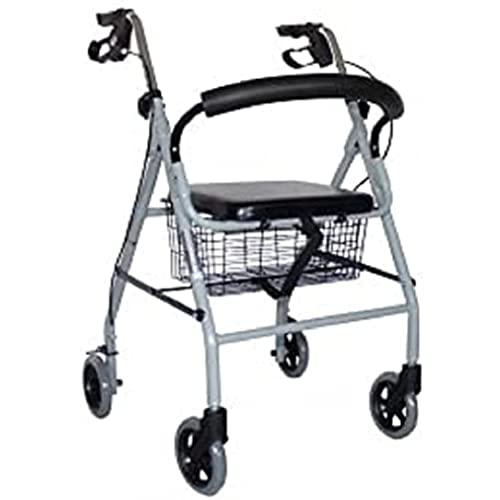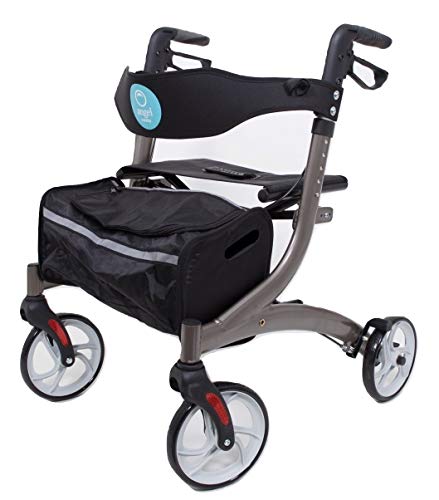Guide To Walking Rollator: The Intermediate Guide To Walking Rollator

2024-12-28 02:24
3
0
본문
 What Is a Walking Rollator?
What Is a Walking Rollator?A walking rollator is a device for mobility that is designed to assist people with difficulties walking. This could be due to chronic health issues that affect gait and balance.
Generally, rollators have large wheels that are able to handle many types of terrain. They are equipped with seats that allow the user to rest and stop whenever needed.
Mobility Aids
A walking rollator helps people move around and navigate their surroundings. Whether they have a condition like multiple sclerosis, arthritis, osteoporosis, or a different debilitating illness, a walker can significantly enhance mobility and stability. It also allows users to remove weight from their legs, relieving pain and weakness in the lower part of the body.
A walker or a hybrid rollator electric is typically constructed from a lightweight metal frame that can be adjusted in height to meet the needs of the user. Most models feature a padded seat and backrest to rest, as well as an accessory basket for personal belongings. Some models come with a brake that is activated by pressing down on the pedal. This is a great feature 2 in 1 rollator wheelchair areas with steep terrain and hills.
Certain models of the rollator are available with pneumatic tires, which are ideal for outdoor use since they provide superior suspension that makes the journey more comfortable and less straining for legs. They also can handle rough terrain and are more maneuverable than the standard walker wheels. They are also quieter and have a higher weight capacity than standard walkers.
Many mobility aids are designed with the possibility of customization and accessories in mind, which means they can be adapted to fit the specific needs of each user. Cup holders, walker trays, and cane/umbrella holders are the most popular options. It's important to select attachments that won't interfere with the folding mechanism and can be removed when not needed.
A walker is the most suitable option if you're in good balance, but require more support for your arms. A walker that is rolling with four wheels is perfect for those who wish to stand for prolonged periods of time. The U-Step II rollator is a unique mobility aid that projects a red laser ahead of the user's body to start movement in Parkinson's patients and to reduce the frequency of freezing gait events. The UpWalker posture walker helps promote more upright standing, which helps to alleviate neck and back pain. It comes with adjustable handgrips for width and a sculpted support surface that is comfortable to grip.
Stability
The sturdy frame and four large wheels of a rollator offer stability to users which reduces the chance of falling and accidents when walking. These mobility aids distribute weight evenly to reduce stress on joints like the knees, hips, and ankles. This feature is particularly beneficial for those recovering from injury or surgery because it reduces the impact of their physical exercise on the healing muscles and joints.
Rollators are available in different sizes, shapes and designs. Some models are light and easy to maneuver, while others have frames made from aluminum or steel that can support a greater user base. They can also be equipped with features like a storage basket as well as locking brakes and cushioned seats for extra comfort. Many manufacturers sell their products on the internet and through health retailers. These companies often offer FSA and HSA-approved products that qualify for income-tax-free spending from these accounts.
A rollator is an excellent option for those who wish to keep their independence, but need help with balance and stability. It can be used to navigate outdoors or indoors and is easily adjusted to work on stairs or uneven surfaces. These aids for mobility are more comfortable than walking aids, because they don't have an fixed seat and can be positioned to meet the needs of the user.
To maximize the benefits of a rolling walker it is essential to understand how to operate it correctly. The first step is to find the appropriate height for the handlebars and seat. Adjust the height so that you can stand straight and place your feet directly beneath the frame. This will help you distribute your weight evenly when you move forward. Then, place your hands on the handles and lean forward, grasping them to keep steady. Once you feel stable you can slowly let the brakes go and begin walking the way you normally do.
One study showed that the use of a rollator slowed down EMG activity in lower-limb muscles during the gait stance phase. However, trunk-sway remained the same. The authors believe this is due to the stabilizing force that are generated by the upper body rather than the lower limbs while walking with a cane that is rolling.
Safety
A rollator offers much more mobility than a standard walker. While standard walkers need to be lifted and set down, then moved, the rolling wheels of a walking rollator walker wheelchair enable it to glide over a variety of surfaces without needing any physical effort. Users can now take walks in the outdoors or do through the city without needing a mobility device.
The wheels of a walking rollator are also designed to withstand rough terrain. While a normal walker might encounter issues with cracks or dips in the sidewalk however, a roll-walker can take on these types of obstacles and allow users to take walking around their neighborhood or even venture out on nature trails without having to worry that their rollator for tall people might not be able to keep pace with.
It is important to practice using aids for mobility even though a walker may be a wonderful tool for seniors to increase their mobility. This is particularly important for new users who are not familiar with a rolling walker, and it is a good idea for anyone to spend some time in the indoors to become comfortable with the aid before going out in the outdoors.
Additionally, it's an excellent idea to make sure that the user knows how to use their brakes and are able to engage them in a timely manner. Some walkers with wheels come with brakes that are activated by pressing down on the frame. Other models have hand brakes similar to those found on bicycles. It is crucial to keep the brakes in motion when using the rollator.
Lastly, it's an excellent idea for seniors to put reflective stickers on their mobility aids or wear brightly colored clothing when they are using them in the winter. This will help to make them more visible to people on the sidewalks or in parking areas and provide beneficial for their safety and their satisfaction levels.
Comfort
Comfort is important when using rollators and walkers for long durations of time. Both types of mobility aids can reduce the chance of falling which can be particularly risky for older adults who suffer from back and hip pain.
The grips on walkers and rollators are designed to ease hand discomfort and provide support for your hands. Plastic handles are common on a variety of walker models, but more comfortable choices include soft and foam materials that absorb shock from repetitive use. You may also wish to consider ergonomically padded armrests for improved support.
The seat height is a major aspect of comfort when using walkers and rolling walker. A walker or rollator that is too low can cause you to sit too much and puts strain on your neck and back. A walker or rollator too high could cause you to lift your legs off the ground. This can put unnecessary stress on your ankles and your back.
Many manufacturers offer a range of accessories for walkers and rollators, such as cup holders, trays storage baskets, and more. These accessories will keep your walker or rolling chair clean, neat and ready to use. They also offer convenience by letting you easily carry your items on the go without having to stop your walk or hold things in your hands.
Both rollator and walker wheels are available in a range of sizes and materials depending on your preferences and requirements. Rubber wheels are a great choice because they offer durability, flexibility, and grip. Polyurethane is also a popular choice because it has the same characteristics as rubber wheels but at a lower cost.
 You can pick from the three-wheel and four-wheel models if you need to move around your home. The three-wheeled walker model is more mobile and more maneuverable than its more powerful four-wheeled counterpart, but it doesn't have seating space for longer excursions. The four-wheeled model is more stable than the three-wheeled version however it can be a challenge to navigate narrow hallways or spaces. A seat can be added to a three-wheeled or four-wheeled walker for extra comfort.
You can pick from the three-wheel and four-wheel models if you need to move around your home. The three-wheeled walker model is more mobile and more maneuverable than its more powerful four-wheeled counterpart, but it doesn't have seating space for longer excursions. The four-wheeled model is more stable than the three-wheeled version however it can be a challenge to navigate narrow hallways or spaces. A seat can be added to a three-wheeled or four-wheeled walker for extra comfort.
댓글목록0
댓글 포인트 안내